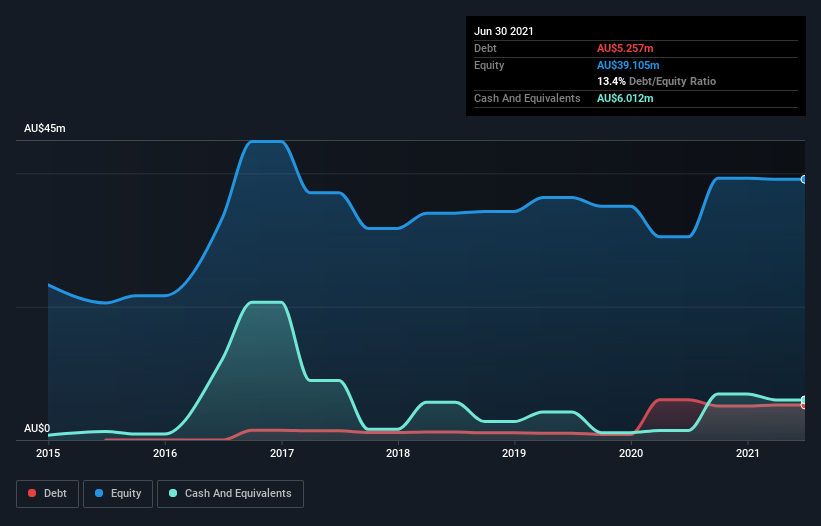Does Tasman Resources (ASX:TAS) Have A Healthy Balance Sheet?
Some say volatility, rather than debt, is the best way to think about risk as an investor, but Warren Buffett famously said that 'Volatility is far from synonymous with risk.' So it might be obvious that you need to consider debt, when you think about how risky any given stock is, because too much debt can sink a company. We note that Tasman Resources Ltd (ASX:TAS) does have debt on its balance sheet. But the real question is whether this debt is making the company risky.
Why Does Debt Bring Risk?
Debt is a tool to help businesses grow, but if a business is incapable of paying off its lenders, then it exists at their mercy. In the worst case scenario, a company can go bankrupt if it cannot pay its creditors. However, a more frequent (but still costly) occurrence is where a company must issue shares at bargain-basement prices, permanently diluting shareholders, just to shore up its balance sheet. By replacing dilution, though, debt can be an extremely good tool for businesses that need capital to invest in growth at high rates of return. The first thing to do when considering how much debt a business uses is to look at its cash and debt together.
Check out our latest analysis for Tasman Resources
How Much Debt Does Tasman Resources Carry?
You can click the graphic below for the historical numbers, but it shows that Tasman Resources had AU$5.26m of debt in June 2021, down from AU$6.03m, one year before. But it also has AU$6.01m in cash to offset that, meaning it has AU$754.9k net cash.
How Strong Is Tasman Resources' Balance Sheet?
We can see from the most recent balance sheet that Tasman Resources had liabilities of AU$5.92m falling due within a year, and liabilities of AU$504.5k due beyond that. On the other hand, it had cash of AU$6.01m and AU$599.7k worth of receivables due within a year. So it can boast AU$188.1k more liquid assets than total liabilities.
Having regard to Tasman Resources' size, it seems that its liquid assets are well balanced with its total liabilities. So while it's hard to imagine that the AU$18.8m company is struggling for cash, we still think it's worth monitoring its balance sheet. Succinctly put, Tasman Resources boasts net cash, so it's fair to say it does not have a heavy debt load! There's no doubt that we learn most about debt from the balance sheet. But you can't view debt in total isolation; since Tasman Resources will need earnings to service that debt. So when considering debt, it's definitely worth looking at the earnings trend. Click here for an interactive snapshot.
Over 12 months, Tasman Resources reported revenue of AU$3.3m, which is a gain of 35%, although it did not report any earnings before interest and tax. With any luck the company will be able to grow its way to profitability.
So How Risky Is Tasman Resources?
We have no doubt that loss making companies are, in general, riskier than profitable ones. And in the last year Tasman Resources had an earnings before interest and tax (EBIT) loss, truth be told. And over the same period it saw negative free cash outflow of AU$9.3m and booked a AU$2.7m accounting loss. Given it only has net cash of AU$754.9k, the company may need to raise more capital if it doesn't reach break-even soon. Tasman Resources's revenue growth shone bright over the last year, so it may well be in a position to turn a profit in due course. Pre-profit companies are often risky, but they can also offer great rewards. When analysing debt levels, the balance sheet is the obvious place to start. However, not all investment risk resides within the balance sheet - far from it. To that end, you should learn about the 5 warning signs we've spotted with Tasman Resources (including 1 which doesn't sit too well with us) .
If, after all that, you're more interested in a fast growing company with a rock-solid balance sheet, then check out our list of net cash growth stocks without delay.
This article by Simply Wall St is general in nature. We provide commentary based on historical data and analyst forecasts only using an unbiased methodology and our articles are not intended to be financial advice. It does not constitute a recommendation to buy or sell any stock, and does not take account of your objectives, or your financial situation. We aim to bring you long-term focused analysis driven by fundamental data. Note that our analysis may not factor in the latest price-sensitive company announcements or qualitative material. Simply Wall St has no position in any stocks mentioned.
Have feedback on this article? Concerned about the content? Get in touch with us directly. Alternatively, email editorial-team (at) simplywallst.com.

 Yahoo Finance
Yahoo Finance 
